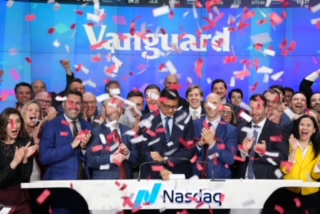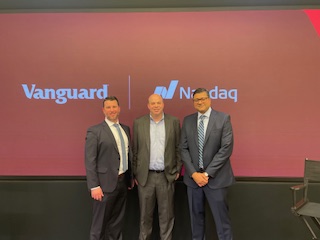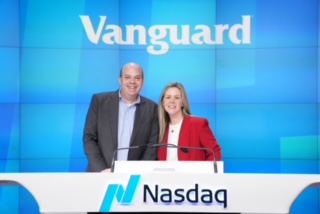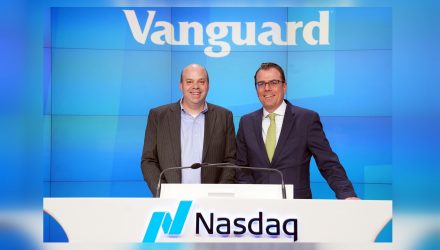Among the larger ETF providers, few have product stability like Vanguard. When changes do occur, that’s worthy of celebration. Last week, some of Vanguard’s fixed income leadership was in New York to help close the stock market at the Nasdaq. VettaFi was honored to join them.
The Vanguard Core Bond ETF (VCRB) and the Vanguard Core-Plus Bond ETF (VPLS) began trading in December. These are both actively managed ETFs run by experienced members of the Vanguard Fixed Income Group that run mutual funds with similar names. Overall, Vanguard’s active fixed income bond mutual funds outperformed their peer group averages over the past 10 years ending September.

Appeal of Active Fixed Income ETFs
While advisors and end clients have long used active management in fixed income through mutual funds, VettaFi is seeing growing demand industrywide for active fixed income ETFs. The Vanguard Ultra-Short Bond ETF (VUSB) has $4.4 billion in assets despite launching less than three years ago. VUSB has an average duration of one year and has a 5.1% 30-day SEC yield.
Yet with the Federal Reserve likely to begin cutting rates in 2024, many advisors are looking to take on more interest rate risk in exchange for potentially higher reward. They are also comfortable with approaches that have the flexibility to adjust based on the market environment. This is where VCRB and VPLS can possibly fit in and compete with other asset managers’ active core ETFs.

VCRB has a 4.9% yield but an average duration of 6.3 years. VCRB recently had most of its assets in U.S. government bonds, but much of the remainder was in A- and BBB-rated bonds. Less than 3% were in speculative-grade bonds. In the first two months of 2024, VCRB declined 1.3%, falling less than 1.6% for the Bloomberg US Aggregate Float Adjusted Index.
This is index tracked by the Vanguard Total Bond Market ETF (BND), the largest U.S.-listed fixed income ETF. BND only invests in investment-grade bonds. The ETF pulled in $1.5 billion of new money this year as of early March.
Taking on Some Additional Credit Risk
The second actively managed intermediate-term bond ETF is VPLS. This ETF has fractionally less duration (6.2 years) but sports a 5.1% yield, higher than VCRB due to elevated credit risk. While VPLS has significant assets in U.S. government bonds and high-grade corporate bonds, it also has 11% in bonds rated less than BBB. In the first two months of 2024, VPLS was down just 1.1%, a narrower loss than its Bloomberg US Universal benchmark.
Adding to their appeal, VCRB and VPLS have relatively low net expense ratios. VCRB charges a fee of 0.10%, while VPLS’ is 0.20%.

We think these newer active ETFs help complement Vanguard’s primarily index-based fixed income lineup. In addition to BND, the Vanguard Intermediate-Term Treasury ETF (VGIT) and the Vanguard Intermediate-Term Corporate Bond ETF (VCIT) gathered more than $1 billion to start the year.
As more advisors embrace active fixed income ETFs, we think Vanguard’s scale and expertise will be valuable. However, in a crowded market, education will be paramount.
For more news, information, and analysis, visit VettaFi | ETF Trends.

